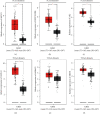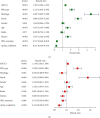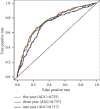Clinicopathological and Prognostic Significance of ABCC3 in Human Glioma
- PMID: 34976054
- PMCID: PMC8718316
- DOI: 10.1155/2021/1827992
Clinicopathological and Prognostic Significance of ABCC3 in Human Glioma
Abstract
Glioma is the most common malignant primary brain tumor with an inferior survival period and unsatisfactory prognoses. Identification of novel biomarkers is important for the improvements of clinical outcomes of glioma patients. In recent years, more and more biomarkers were identified in many types of tumors. However, the sensitive markers for diagnoses and prognoses of patients with glioma remained unknown. In the present research, our team intended to explore the expression and clinical significance of ABCC3 in glioma patients. Sequential data filtration (survival analyses, independent prognosis analyses, ROC curve analyses, and clinical association analyses) was completed, which gave rise to the determination of the relationship between glioma and the ABCC3 gene. Clinical assays on the foundation of CGGA and TCGA datasets unveiled that ABCC3 expression was distinctly upregulated in glioma and predicted a shorter overall survival. In the multivariable Cox analysis, our team discovered that the expression of ABCC3 was an independent prognosis marker for both 5-year OS (HR = 1.118, 95% CI: 1.052-1.188; P < 0.001). Moreover, our team also studied the association between ABCC3 expression and clinical features of glioma patients, finding that differential expression of ABCC3 was remarkably related to age, 1p19q codeletion, PRS type, chemo status, grade, IDH mutation state, and histology. Overall, our findings suggested ABCC3 might be a novel prognosis marker in glioma.
Copyright © 2021 Dan-Dong Fang et al.
Conflict of interest statement
The authors declare no conflicts of interest.
Figures





Similar articles
-
Analysis of ABCC3 in glioma progression: implications for prognosis, immunotherapy, and drug resistance.Discov Oncol. 2025 Feb 13;16(1):179. doi: 10.1007/s12672-025-01895-8. Discov Oncol. 2025. PMID: 39948325 Free PMC article.
-
A nuclear transport-related gene signature combined with IDH mutation and 1p/19q codeletion better predicts the prognosis of glioma patients.BMC Cancer. 2020 Nov 9;20(1):1072. doi: 10.1186/s12885-020-07552-3. BMC Cancer. 2020. PMID: 33167941 Free PMC article.
-
A Novel Immune-Related Prognostic Biomarker and Target Associated With Malignant Progression of Glioma.Front Oncol. 2021 Apr 16;11:643159. doi: 10.3389/fonc.2021.643159. eCollection 2021. Front Oncol. 2021. PMID: 33937046 Free PMC article.
-
Bioinformatics Analysis of the Expression of ATP Binding Cassette Subfamily C Member 3 (ABCC3) in Human Glioma.Open Med (Wars). 2020 Feb 28;15:107-113. doi: 10.1515/med-2020-0016. eCollection 2020. Open Med (Wars). 2020. PMID: 32161779 Free PMC article.
-
TERT promoter mutation and its interaction with IDH mutations in glioma: Combined TERT promoter and IDH mutations stratifies lower-grade glioma into distinct survival subgroups-A meta-analysis of aggregate data.Crit Rev Oncol Hematol. 2017 Dec;120:1-9. doi: 10.1016/j.critrevonc.2017.09.013. Epub 2017 Oct 3. Crit Rev Oncol Hematol. 2017. PMID: 29198322 Review.
Cited by
-
Analysis of ABCC3 in glioma progression: implications for prognosis, immunotherapy, and drug resistance.Discov Oncol. 2025 Feb 13;16(1):179. doi: 10.1007/s12672-025-01895-8. Discov Oncol. 2025. PMID: 39948325 Free PMC article.
-
TMEM35B as a novel biomarker for diagnosing gliomas.Biomark Med. 2024 Dec;18(24):1103-1111. doi: 10.1080/17520363.2024.2431480. Epub 2024 Nov 26. Biomark Med. 2024. PMID: 39589905
-
Hypoxia-related THBD+ macrophages as a prognostic factor in glioma: Construction of a powerful risk model.J Cell Mol Med. 2024 May;28(10):e18393. doi: 10.1111/jcmm.18393. J Cell Mol Med. 2024. PMID: 38809929 Free PMC article.
-
The combined signatures of telomere and immune cell landscape provide a prognostic and therapeutic biomarker in glioma.Front Immunol. 2023 Aug 17;14:1220100. doi: 10.3389/fimmu.2023.1220100. eCollection 2023. Front Immunol. 2023. PMID: 37662954 Free PMC article.
-
Predicting Treatment Outcomes in Glioblastoma: A Risk Score Model for TMZ Resistance and Immune Checkpoint Inhibition.Biology (Basel). 2025 May 20;14(5):572. doi: 10.3390/biology14050572. Biology (Basel). 2025. PMID: 40427760 Free PMC article.
References
LinkOut - more resources
Full Text Sources

